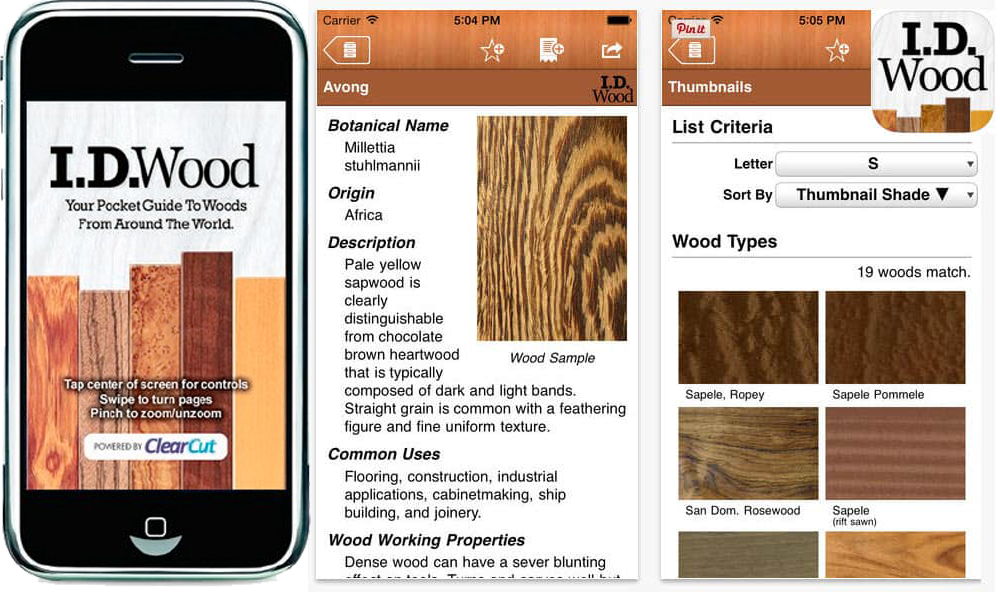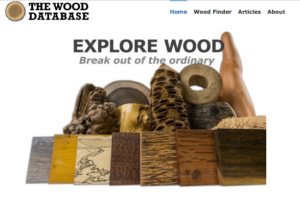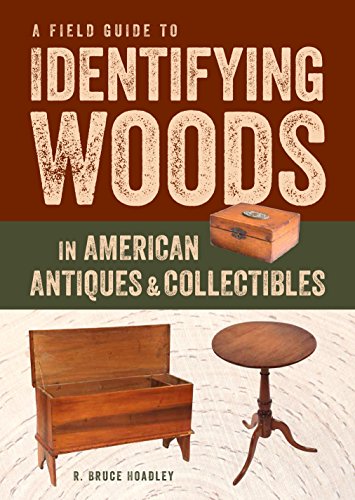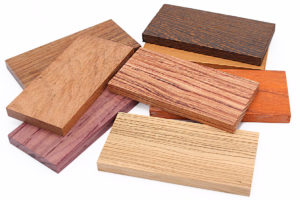The Best Resources for Identifying Wood & Lumber
What wood is this?
Anyone working with wood and lumber will at some point need to identify an unknown species which can often be difficult. Identifying wood species is a science and an art that is all too frequently overlooked. In addition to aesthetics, proper species selection is extremely important in construction as different species will be able to handle different load stresses, withstand different climates, bend and twist in different ways and be apprpritately suited for different applications. Below are several resources I’d recommend as aides in identifying wood, however, the only 100% accurate method is to send a sample away for a lab test, see Lab Tests section below.
Digital Resources:
I.D. Wood App
I created the I.D. Wood iPhone/iPad App back in 2009 when iPhones were first introduced and the iTune App store was in its infancy. The app is meant to be a virtual wood encyclopedia that is always available for reference so long as you have your phone with you. The app contains over 200 different wood sample photos, many with end-grains, common uses, woodworking characteristics, alternate names, origins, durability and more. This was a fun project to put together though a ton of work but the app remains a best selling reference guide for aiding in the identification of wood.

A common question I get from time to time is why doesn’t the app identify wood for you? I agree that would be awesome! However, anyone who understands wood beyond the basics will tell you that would be nearly impossible, given the variables in color, thickness, grain, age, application, and lack of microscopically examining end grain porosity. Simply matching a photo using smart technology will not give accurate results. Experts even frequently come up with different identifications based on visual observations. So yes that would be awesome to point your phone at a piece of wood and just like Shazam have a match, but we’re not there yet, maybe someday. In the meantime, if you need a quick pocket guide to wood, check out I.D. Wood available on iTunes. Its a past Apple Staff Favorite and has been covered by Bob Vlla, Fine Woodworking, This Old House, The New York Times and others.
Wood Handbook – Wood as an Engineering Material
The Wood Handbook is one of the most widely used documents in the wood literature. The 2010 edition is the first update of the 21st century and includes several new chapters. The original handbook was first published in 1935 by the USDA Forest Products Laboratory (FPL). More information is available at the U.S. Forest Service, Forest Products Laboratory Website.
The Wood Database
 The Wood Database is a very cool online project by Eric Meier. Eric started a personal database of wood for his own interest in 2007 and eventually compiled his collection into an online database of wood species, sample photos, characteristices and more. In addition to the very useful Wood Finder feature, Eric has compiled a very nice list of articles on the topic of identifying wood. Eric has also recently published a book on wood identifcation available on Amazon. Although I’ve not personally had a chance to review the book, I’ve heard good things about WOOD! Identifying and Using Hundreds of Woods Worldwide and it has nearly 200 positive reviews.
The Wood Database is a very cool online project by Eric Meier. Eric started a personal database of wood for his own interest in 2007 and eventually compiled his collection into an online database of wood species, sample photos, characteristices and more. In addition to the very useful Wood Finder feature, Eric has compiled a very nice list of articles on the topic of identifying wood. Eric has also recently published a book on wood identifcation available on Amazon. Although I’ve not personally had a chance to review the book, I’ve heard good things about WOOD! Identifying and Using Hundreds of Woods Worldwide and it has nearly 200 positive reviews.
Books & Literature:
Hoadley’s Understanding Wood
For a deeper dive, I’d recommend what many professional woodworker’s refer to as the wood bible; Bruce Hoadley’s outstanding book called Understanding Wood.
The first edition of Understanding Wood was published in 1980 and has since sold more than 130,000 copies.  It is widely held as a definitive reference work and the cornerstone of every woodworker’s library. Hoadley’s comprehensive guide to wood technology is continually revised and updated.
It is widely held as a definitive reference work and the cornerstone of every woodworker’s library. Hoadley’s comprehensive guide to wood technology is continually revised and updated.
The 20th Anniversary Edition of Hoadley’s wood reference encyclopedia contains new information on composite materials, adhesives, and finishes brings this book into the 21st century, while more than 300 photographs bring important visual information to life. This edition covers the nature of wood and its properties, the basics of wood technology, and the woodworker’s raw materials. Understanding Wood was written for woodworkers by a scientist with a love of woodworking. It will be sought after by craftsmen and collectors alike.
Terry Porter’s Wood Identification & Use
 While Bruce Hoadley’s multiple books on wood are wonderful for exploring the science behind wood and developing a deep and thorough understanding of wood’s complexity, think fibers and physics, Terry Porter’s Wood Identification & Use is more of a sampler in different species and great a great book to have in your wood working library to page through.
While Bruce Hoadley’s multiple books on wood are wonderful for exploring the science behind wood and developing a deep and thorough understanding of wood’s complexity, think fibers and physics, Terry Porter’s Wood Identification & Use is more of a sampler in different species and great a great book to have in your wood working library to page through.
If you like the tactile qualities of a book and collect samples of wood, flooring, tiles, paint, stain, nuts, bolts, nails etc., check out Wood Identifcation & Use. Each species has a whole page including a photo and common uses, characteristics and other information. Also quite useful are the various appendices which allow you to cross reference common names, and tables that help sort through other traits of each type of wood. The layout of this book is very nice and easy to use, though the photos could be improved and the single photo for many of the species is just a taste of what a wood can look like.
Identifying Wood in American Antiques & Furniture
Believe it or not, the wood used to construct early American furniture is much different than most of the wood you’ll find growing today, even of the same species. One of the reasons for this variation is the denisty of the old growth forests and blights. Much of the eastern seaboard, where the lumber for early American furniture originated, was covered in vast spans of dense forests. In these forests, trees grew straight and tall and the growth rings which each represent a single year were very small and tight, resulting in beautiful and strong lumber. Most of the old growth forests no longer exist today and where they do they are rightfully protected.
The lumber most commonly available today grows much faster which means each year’s growth rings are thicker and not nearly as strong. Production forests grow very fast and are then harnested as a commodity but the resulting lumber leaves a lot to be desired and this is one of the reasons reclaimed wood can demand a premium price.
Blights also wiped out several species of trees that were used for early American furniture including American Chestnut & American Elm. These trees once grew in abundance but they were wiped out by disease and only a few specimens exist. If you’re interested in American Antiques and Furniture and the lumber used to build it, the best resource I’ve come across is another Hoadley book called Identifying Wood in American Antiques & Furniture. Its available in paperback or digitally on Kindle and well worth the price.
Lab Tests:
Center for Wood Anatomy Research
The U.S. Forest Service operates the Center for Wood Anatomy Research and allows private U.S. Citizens to submit up to 3 samples of wood for identifcation per year. It is unclear if they support woods from around the globe or only those originating in the United States but if you need to identify a type of wood, this may be a good resource.
The Global Timber Tracking Network
The Global Timber Tracking Network (GTTN) reports that “Scientists can make use of different techniques to identify the species to which a piece of wood belongs, and its geographical origin. Depending on the technique used, the test piece can be tiny (e.g. veneer a few millimetres thick or a sliver cut from a piece of art), small (e.g. a few cubic centimetres cut from a piece of furniture) or its actual size (non-destructive methods). In addition to the sample size needed for the analysis, each technique has its advantages and limitations. Consequently, one of GTTN’s goals is to facilitate the integration of these different methods.
The GTTN has three different methods of identifying wood species, including Wood Anatomy, Wood Chemistry and Wood Molecular Biology. “Aside from the well-established wood anatomical method, timber-tracking techniques are innovative and still evolving. The most pressing need is to extend the collection of reference data, which form the basis for the verification of species and origin of a traded wood-based product”.
Local Identification Resources
For identifying wood species used in furniture and architecture, there is a good chance that local historians and art conservationists may be able to help. Ever watch the Antiques Roadshow? These experts have knowledge that you just can’t find online. Local foresters and engineers at lumber yards are another potential resource and finally do a local google search for colleges and universities that may be able to help. Keep in mind though that the art and science of identifying wood is not exact and different experts may arrive at different conclusions.
Wood Samples
Another helpful tool in the identification of wood species is to build your own collection of samples that you can then compare to whatever wood you are looking to identify. With physical wood species samples you can enjoy, examine and learn to recognize the rich color, fascinating grain and distinctive texture of some of the woods and veneers used on furniture, historic architecture, musical instruments, ships, weapons and more. You can accumulate samples of known woods over time, trade samples with other wood workers and even purchase wood samples as small boards or veneers. Believe it or not there are several organizations focused on wood collection.
Wood Veneers
One way to start to build a collection of different wood species is to obtain small pieces of wood veneers. This will give you some sense of the wood’s appearance and grain patterns and provide a physical sample to hold. There are several variety packs available to purchase at a reasonable price like the Sauer’s Wood Identification Kit on Amazon. Ebay is also a great source for finding variety packs of wood veneers from manufacturers that may now be out of business. 
The Sauer’s Wood Identification kit for example contains 50, 4″ x 9″ wood veneer samples some of the world’s most colorful woods from the four corners of the earth – India, Ceylon, South America, East Indies, Australia and the U.S.A. Each sample is labeled and identified by its common name and country of origin. It can help you select your favorite wood for your next shop project and can be used in small craft work or for testing various finishes. Based on the availability of certain species, the kit content is constantly changing.
While wood veneers are a great way to start your collection, one of the shortcomings of veneers is the fact that you will not be able to examine end grain since the samples are typically no more than 1/8″ thick and many times thinner than that. As you get further into the field of wood identification, you’ll start to learn the importance of end grain in wood identification. When that time comes, look to start building a collection of thicker samples. There is even a group dedicated to the collection of wood samples with standardized guidelines.
International Wood Collector’s Society Samples
The International Wood Collector’s Society is a dedicated group of wood collectors and crafters that is open to join on an annual membership basis.

In response to the requests of wood collectors, the International Wood Collectors Society endeavors to supply wood specimens of 80 species in a starter kit. Prepared specimens measuring 0.5 x 3 x 6 inches are available in kits containing up to 44 specimens. Whether used for studying wood structure or identification, these specimens will prove to be a valuable resource of information to collector, tradesman, craftsman, teacher, or hobbyist alike. Specimens are shipped in a padded cardboard box and are numbered to correspond to the list below. Also included is an eight-page wood identification bulletin with an identification keys and photos. The cost for the kit is $100 for members and $160 for non-members.
For expanding your collection into more exotic and hard to find woods, members of the International Wood Collector’s Society frequently trade and sell samples they’ve collected and generally follow a standardized sample size guideline for uniformity of 0.5 x 3 x 6 inches. Occasionally the size will vary depending on availability. I’ve purchased numerous samples from members of the International Wood Collector’s Society myself when scanning high resolution images for the I.D. Wood app.
While digital images and books are wonderful resources, there is really no replacement for having a real sample on hand to touch and examine to get to know a new species of wood while reading about the specific traits unique to each species of lumber.
Center for Wood Anatomy Research
The USDA Forest Products Laboratory in Madison, Wisconsin, houses the world’s largest reference collection of woods, and specializes in wood identification. Instructions on how to prepare and submit samples for identification by the Center for Wood Anatomy Research. If you’re ever in Madison, it may be worth trying to organize a visit. If you do, we’d love to hear about it!
Education, Courses & Workshops
Finally if you really get into the art and science of identifying and understanding wood, there are actually courses and classes offered on the general topic of wood identification and use, as well as extremely specific deep dives into things like wood in musical instruments, wood in European furniture, wood applications in historic bridge preservation and much more.
Courses are offered by the following organizations to name a few:
The American Institute for the Conservation of Historic and Artistic Works
Kew Royal Botanic Gardens outside of London, England
The International Preservation Studies Center
The National Center for Preservation Technology and Training